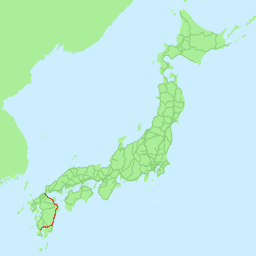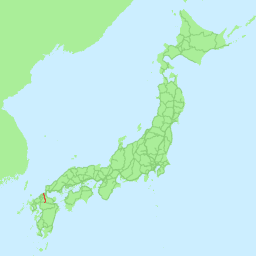|
Jōno Station (JR Kyushu)
is a passenger railway station located in Kokuraminami-ku, Kitakyushu, Fukuoka Prefecture, Japan. It is operated by JR Kyushu. Lines Jōno Station is served by the Nippō Main Line and is located 6.1 km from the starting point of the line at . It is also the northern terminus for the 39.4 kilometer Hitahikosan Line to , although most trains continue for another 2.6 kilometers to terminate at Layout The station consists of one side platform and two island platforms, connected by an elevated station building. The station has a ''Midori no Madoguchi'' staffed ticket office. Platforms History Jōno Station was established on 1 April 1895 as a station on the Kyushu Railway. The railway was nationalized in 1907. With the privatization of the JNR on 1 April 1987, the station came under the control of JR Kyushu The , also referred to as , is one of the seven constituent companies of Japan Railways Group (JR Group). It operates intercity rail services within K ... [...More Info...] [...Related Items...] OR: [Wikipedia] [Google] [Baidu] |
Midori No Madoguchi
, short for ''Magnetic-electronic Automatic'' ''Reservation System,'' is a train ticket reservation system used by the Japan Railways Group (JR Group) companies and travel agencies in Japan. It was developed jointly by Hitachi and the former Japanese National Railways (JNR), and inherited by the (JR Systems), which is jointly owned by the seven railway companies of the JR Group: the East Japan Railway Company (JR East), Central Japan Railway Company (JR Central), West Japan Railway Company (JR West), Hokkaido Railway Company (JR Hokkaido), Shikoku Railway Company (JR Shikoku), Kyushu Railway Company (JR Kyushu), and Japan Freight Railway Company (JR Freight). The MARS system used in JR ticket offices is Japan’s largest online real-time system, providing a year-round availability of 99.999%. It offers a range of services, including seat reservations on Shinkansen and Limited Express trains and fare calculation for basic fare tickets, commuter passes, and express tickets. ... [...More Info...] [...Related Items...] OR: [Wikipedia] [Google] [Baidu] |
Railway Station
Rail transport (also known as train transport) is a means of transport using wheeled vehicles running in railway track, tracks, which usually consist of two parallel steel railway track, rails. Rail transport is one of the two primary means of land transport, next to road transport. It is used for about 8% of passenger and rail freight transport, freight transport globally, thanks to its Energy efficiency in transport, energy efficiency and potentially high-speed rail, high speed.Rolling stock on rails generally encounters lower friction, frictional resistance than rubber-tyred road vehicles, allowing rail cars to be coupled into longer trains. Power is usually provided by Diesel locomotive, diesel or Electric locomotive, electric locomotives. While railway transport is capital intensity, capital-intensive and less flexible than road transport, it can carry heavy loads of passengers and cargo with greater energy efficiency and safety. Precursors of railways driven by human or an ... [...More Info...] [...Related Items...] OR: [Wikipedia] [Google] [Baidu] |
Fukuoka Prefecture
is a Prefectures of Japan, prefecture of Japan located on the island of Kyūshū. Fukuoka Prefecture has a population of 5,109,323 (1 June 2019) and has a geographic area of 4,986 Square kilometre, km2 (1,925 sq mi). Fukuoka Prefecture borders Saga Prefecture to the southwest, Kumamoto Prefecture to the south, and Ōita Prefecture to the southeast. Fukuoka is the capital and largest city of Fukuoka Prefecture, and the largest city on Kyūshū, with other major cities including Kitakyushu, Kurume, and Ōmuta, Fukuoka, Ōmuta. Fukuoka Prefecture is located at the northernmost point of Kyūshū on the Kanmon Straits, connecting the Tsushima Strait and the Seto Inland Sea across from Yamaguchi Prefecture on the island of Honshu, and extends south towards the Ariake Sea. History Fukuoka Prefecture includes the Old provinces of Japan, former provinces of Chikugo Province, Chikugo, Chikuzen Province, Chikuzen, and Buzen Province, Buzen. Shrines and temples Kōra taisha, Sumiyoshi-j ... [...More Info...] [...Related Items...] OR: [Wikipedia] [Google] [Baidu] |
JR Kyushu
The , also referred to as , is one of the seven constituent companies of Japan Railways Group (JR Group). It operates intercity rail services within Kyushu, Japan. It formerly operated the Beetle hydrofoil service across the Tsushima Strait between Fukuoka and Busan, South Korea, before its discontinuation in 2024. It also operates hotels, restaurants, and drugstores across its service region. JR Kyushu's headquarters are in Hakata-ku, Fukuoka. ." Kyushu Railway Company. Retrieved on March 27, 2010. History When was divided in 1987, Kyushu Railway Company inherited its assets and operations on the island of |
Nippō Main Line
The is a railway line in Kyushu, in southern Japan, operated by Kyushu Railway Company (JR Kyushu). Also known as the Fukuhoku Nippo Line, The line connects Kokura Station in Kitakyushu, Fukuoka, and Kagoshima Station in Kagoshima, Kagoshima, Kagoshima via the east coast of Kyushu, passing through the Prefectures of Japan, prefectural capitals of Ōita, Ōita, Ōita and Miyazaki, Miyazaki, Miyazaki. A number of Limited Express trains operate along the route, including Limited Express Sonic trains between Hakata and Oita. Stations :●: Stops :▲: Rapid service connecting to Hitahikosan Line non-stop, :|: Non-stop :Liner services: ''Sawayaka Liner'', ''Home Liner'' Though Kagoshima is the southern terminus for the line, some trains continue via the Kagoshima Main Line to the adjacent Kagoshima-Chūō Station, Kagoshima-Chūō station. History The Kyushu Railway Co. opened the 6 km Kokura - Jono section in 1895, and the Hōshū Railway Co. opened the 46 km Yukuhas ... [...More Info...] [...Related Items...] OR: [Wikipedia] [Google] [Baidu] |
Terminal Station
A train station, railroad station, or railway station is a railway facility where trains stop to load or unload passengers, freight, or both. It generally consists of at least one platform, one track, and a station building providing such ancillary services as ticket sales, waiting rooms, and baggage/freight service. Stations on a single-track line often have a passing loop to accommodate trains travelling in the opposite direction. Locations at which passengers only occasionally board or leave a train, sometimes consisting of a short platform and a waiting area but sometimes indicated by no more than a sign, are variously referred to as "stops", "flag stops", " halts", or "provisional stopping places". The stations themselves may be at ground level, underground, or elevated. Connections may be available to intersecting rail lines or other transport modes such as buses, trams, or other rapid transit systems. Terminology ''Train station'' is the terminology typicall ... [...More Info...] [...Related Items...] OR: [Wikipedia] [Google] [Baidu] |
Hitahikosan Line
The is a railway line in Japan, operated by Kyushu Railway Company (JR Kyushu). It connects Jōno Station (JR Kyushu), Jōno Station in Kitakyushu, Fukuoka Prefecture with Yoake Station in Hita, Ōita Prefecture and features the 4380 m Shakadake Tunnel between Chikuzen Iwaya and Hikosan station, where a fatal tunnel collapse occurred during construction in 1953, killing 21 construction workers. The line is named after Hita and Mount Hiko. The bus rapid transit portion of the line is referred to as the . Stations :●: Stops, |: non-stop History On 1 April 1960, the Hitahikosan Line was formed by a merger of the following lines: *Main line ** Jōno – Kawara and Soeda – Yoake sections of the Hita Line (the remaining Kawara – Soeda section became the Soeda Line) ** Kawara – Ita branch of the Hita Line ** Ita – Soeda section of the Tagawa Line (the Yukuhashi – Kawara section remained as the Tagawa Line) *Branches ** Ishida – freight branch of the Hita Line ** Busz ... [...More Info...] [...Related Items...] OR: [Wikipedia] [Google] [Baidu] |
Side Platform
A side platform (also known as a marginal platform or a single-face platform) is a platform positioned to the side of one or more railway tracks or guideways at a railway station, tram stop, or transitway. A station having dual side platforms, one for each direction of travel, is the basic design used for double-track railway lines (as opposed to, for instance, the island platform where a single platform lies between the tracks). Side platforms may result in a wider overall footprint for the station compared with an island platform, where a single width of platform can be shared by riders using either track. In some stations, the two side platforms are connected by a footbridge or tunnel to allow safe access to the alternate platform. While a pair of side platforms is often provided on a dual-track line, a single side platform is usually sufficient (trains are usually only boarded from one side) for a single-track line. Layout Where the station is close to a level crossing (g ... [...More Info...] [...Related Items...] OR: [Wikipedia] [Google] [Baidu] |
Island Platform
An island platform (also center platform (American English) or centre platform (British English)) is a station layout arrangement where a single platform is positioned between two tracks within a railway station, tram stop or transitway interchange. Island platforms are sometimes used between the opposite-direction tracks on twin-track route stations as they are cheaper and occupy less area than other arrangements. They are also useful within larger stations, where local and express services for the same direction of travel can be accessed from opposite sides of the same platform instead of side platforms on either side of the tracks, simplifying and speeding transfers between the two tracks. The historical use of island platforms depends greatly upon the location. In the United Kingdom the use of island platforms on twin-track routes is relatively common when the railway line is in a cutting or raised on an embankment, as this makes it easier to provide access to the platf ... [...More Info...] [...Related Items...] OR: [Wikipedia] [Google] [Baidu] |
Jōno Station (Kitakyushu Monorail)
is a Kitakyūshū Monorail station in Kokurakita-ku, Kitakyūshū, Japan. It shouldn't be confused with the Jōno Station of JR Kyushu, located about 500m eastward. History The station opened on 9 January 1985, coinciding with the opening of the Kitakyushu Monorail. Station layout The elevated station has two side platform A side platform (also known as a marginal platform or a single-face platform) is a platform positioned to the side of one or more railway tracks or guideways at a railway station, tram stop, or transitway. A station having dual side platforms, ...s with two tracks. Platforms References Railway stations in Japan opened in 1985 Railway stations in Fukuoka Prefecture {{monorail-stub ... [...More Info...] [...Related Items...] OR: [Wikipedia] [Google] [Baidu] |





